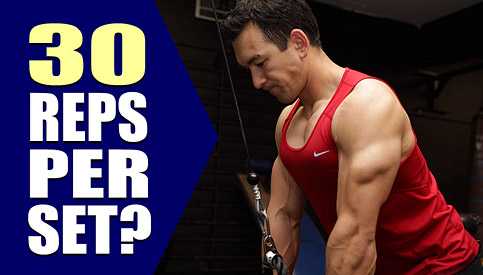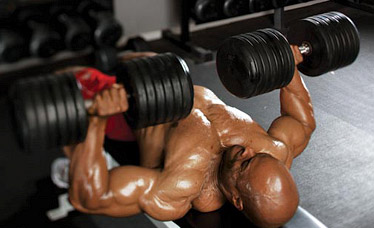IS 30 REPS PER SET EFFECTIVE FOR BUILDING MUSCLE?

Can You Build Muscle With 30 Reps Per Set?
In this article we’ll break down the truth when it comes to the optimal hypertrophy rep range.
Lately, the traditional bodybuilding “hypertrophy rep range” that is typically recommended for muscle growth (around 6-12 reps per set) has come under fire.
This is because several new studies have now shown that high rep workouts all the way up to 30 reps per set can produce comparable muscle gains as long as they use at least 30% of your one-rep max and are taken close to muscular failure.
So, what rep range should you be following if you’re trying to maximize muscle growth?
30 Reps For Mass: Fact Or Fiction?
While these newer studies don’t definitively prove that 30 reps per set would build muscle in exactly the same way as low to moderate rep sets in the long term, it does look like the results would be pretty close either way.
Beyond the specific rep range you use or whether you use light weight vs. heavy weight, it’s clear that the most important factor for building muscle is that you simply train within a few reps of muscular failure (the point in the set where you cannot complete any additional reps in proper form) and apply progressive overload over time.
If for some reason you prefer high reps vs. low reps or you have no choice but to train that way to accommodate equipment limitations or a bodybuilding injury, you shouldn’t have any problem gaining muscle effectively with that approach.
Whether it’s 5 reps, 10 reps, 20 reps or all the way up to 30 reps per set or more, the central key is that you simply train hard with proper form and gradually progress over time.
However, although 30 reps may produce the same muscle growth on a set per set basis, the traditional “muscle building rep range” still reigns supreme when you extrapolate things over the course of an entire workout.
Why The Standard “Hypertrophy Rep Range” Is Still King

At the end of the day, muscle growth is an adaptive response to stress.
It results from you doing something that challenges the existing strength capacity of the muscle.
In other words, it’s only the last few reps of the set as you approach muscle failure that actually trigger a significant muscle building response.
Around 3-4 reps short of failure is where meaningful muscle growth will be stimulated, with about 1-2 reps in reserve being the general “sweet spot” for achieving the very best gains. (Sets taken all the way to complete failure can be added in here and there as well)
For example, if you were doing a set of 10 pull ups, the only real purpose of reps 1-5 is to get you to reps 6-10 where muscle growth is being stimulated.
These are the reps (often referred to as “effective reps”) that actually signal to the body that you’re attempting to do something challenging which needs to be adapted to.
In the case of a 30 rep set, this means you’ll need to perform approximately 25 reps or so before you get to the point where you’re benefiting from those last few effective reps.
As a result, you’ll be accumulating a much larger amount of “junk volume” and overall fatigue relative to stimulative effective reps.
Not only is this a downside in terms of basic time/effort efficiency, but there are also several direct physical and mental drawbacks to performing too many high rep sets in the same workout, whether it’s 30 reps per set or even a lower amount such as 20 reps.
High Reps And The Cardiovascular System

One issue is that there will be a larger cardiovascular component involved when you train in very high rep ranges.
If your goal is to improve cardiovascular fitness and you’re using weight training as a cardio exercise, then this is completely fine.
However, if your goal is to maximize your bottom line muscle growth, you don’t want your cardiovascular system to become a limiting factor during your sets.
This probably won’t be an issue on smaller isolation movements like a side lateral raise or a biceps curl or a calf raise.
But for bigger lifts, such as squats, deadlifts, compound back exercises and bench presses, this can definitely become an issue.
Even though you’ll be using a lighter weight,your cardiovascular system will come much more into play when doing high reps vs. low reps.
The excessive cardiovascular influence of high rep workouts can take your focus away from what truly matters for hypertrophy, which is training close to muscular failure and achieving consistent progressive overload.
This cardio component won’t just affect you during one single set either. Excessive cardiovascular dominance will have a cumulative effect as your workout goes on.
Once again, this would be okay depending on your fitness goals, but if your goal is optimizing muscle growth, then a large number of very high rep sets will not be ideal on larger compound movements.
Excessive Fatigue And “Muscle Burn”

Higher rep sets force your mind to stay focused for a longer period of time during each set. This could make it more difficult to get your set right up near true muscular failure.
It’ll also mean a greater chance of your form slipping up as you start reaching the end of the set.
In addition, sub-optimal form could reduce the activation of the muscle you’re trying to target and could also increase your chances of injuring yourself.
Many people will say that the benefit of performing high rep sets and using light weight vs. heavy weight is that they achieve a better “muscle burn”.
This might seem like a good thing on the surface, but it can actually be counterproductive in some cases since the discomfort of that burning sensation may force you to terminate the set too early before you’ve actually reached the effective rep zone.
Building muscle is NOT about how much muscle burn, muscle pump or muscle soreness you can create.
As we’ve mentioned several times now, getting your set close to true muscular failure and applying progressive overload over time is the key. Burn, pump and soreness are simply natural byproducts of that process.
So, How Many Reps Per Set Should You Perform?
The intention here is not to demonize those light weight high rep sets; it’s simply to point out that basing the majority of your training around those sets will likely not be ideal for gaining muscle in the most effective way (and certainly won’t be optimal for increasing lifting strength).
If you want to add some high rep work into your training for whatever reason (whether it’s 30 reps per set or even higher) then that’s perfectly fine.
However, if your goal is to gain muscle with maximum effectiveness, optimize your stimulus to fatigue ratio and generate the highest quality muscle building sets possible, the traditional bodybuilding “hypertrophy rep range” (I recommend basing the majority of sets around the 5-10 range) will still be the best approach in most cases.
Going slightly higher than this is fine (for example, 12 reps per set is still highly effective), but this general 5-10 range will allow you to accumulate the highest number of effective reps without creating unnecessary fatigue and prolonging your time in the gym.
It’s high enough to avoid the various drawbacks we just discussed, while also being light enough to prevent excessive joint stress and injury risk.
Any rep range can build muscle effectively if sufficient effort is generated and progressive overload is applied, but 30 reps per set should still be used sparingly unless it’s absolutely necessary for you to train in that high of a rep range.
If you found this article helpful, make sure to sign up for your FREE custom fitness plan below...





